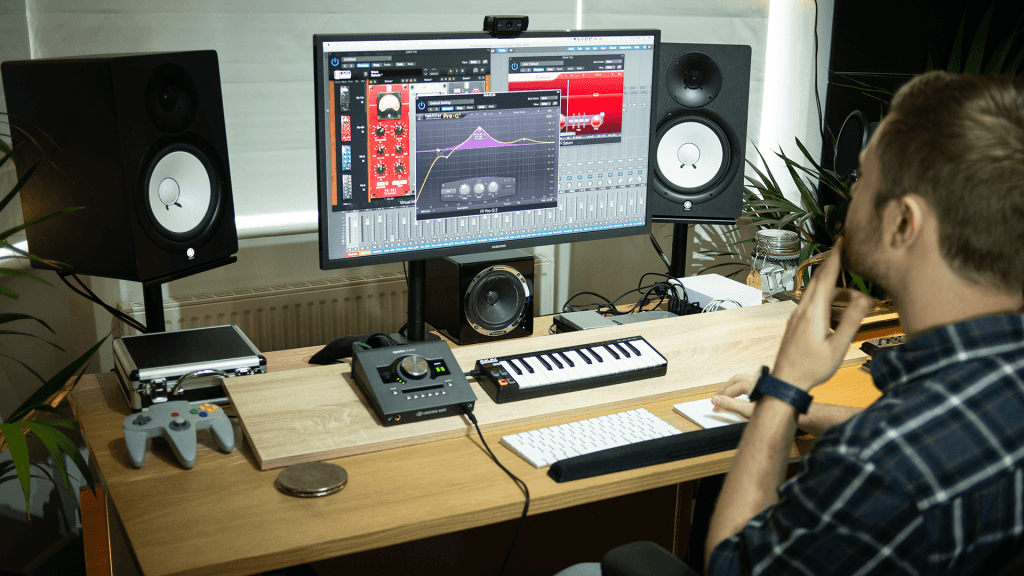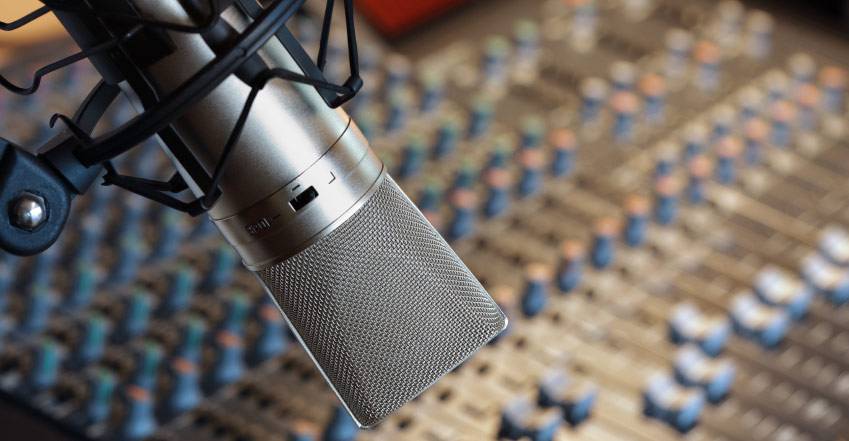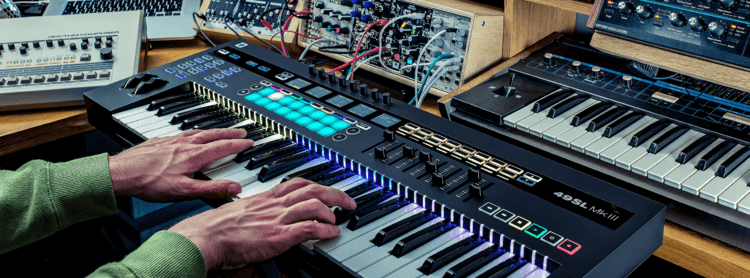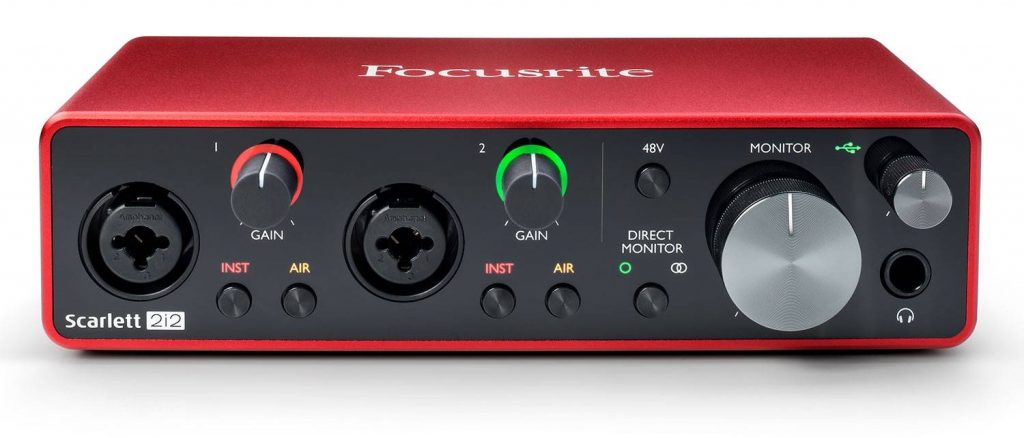So you’re studying music tech and now you want to make music at home.
Where do you start?
Importantly – you don’t need some of the amazing (and expensive) kit you might have seen at school or in studios. It would be great but you don’t have that kind of money or enough space, right? Well don’t worry – we’re here to help and in this post we’ll be covering all the basics that you need for a simple set up to get the killer ideas out of your head and out to the world.

For this post, we’re going to assume you have (or have access to) a computer – it’s perfectly possible to produce awesome content on an iPad, but we’ll cover that another time. The computer is where the magic is going to happen and one with a powerful processor and as much RAM as possible will make your life easier. Other than a computer, here’s what you might need:
- Software
- Audio Interface
- Microphones
- Speakers & Headphones
- Controllers
What software should I use?
This depends on how you want to create music and there are several standards that would be the best places to start. These are called DAW’s (Digital Audio Workstations) and include instruments and effects, although there are lots of extra ones you can buy separately. However, don’t rush out to buy a DAW just yet – you often get entry-level versions of these with some other bits of kit you’ll need so read on….
Two of the biggest names in the game are Cubase and Ableton, both of which work on PC and Mac platforms so we’ll focus on them. (Logic Pro is also amazing and even GarageBand can generate some awesome results, but only if you have a Mac!).
- Cubase (made by Steinberg) has been around pretty much since the dawn of computer music and is still one of the best out there – it’s also the program that most schools tend to use, so you might have seen it in action. The basic version is called Cubase Elements and is a crazy powerful programme for recording and composing with an insane set of features, instruments and tools that are enough to get you writing straight away.
- Ableton Live is also extremely popular but works in a slightly different way. Although you can record straight into it like Cubase, Live is built more around the idea of using it for live performance as well as production. It has become one of the most widely used programmes in electronic music, hip-hop and other genres because it moves so well from studio to stage, using loops, clips, hits and software instruments to make music. The basic version is called Ableton Live Intro and comes with more than enough to start building tracks right out of the box.
Basically – Cubase will give you a more traditional ‘studio’ feel to your home studio, while might offer a more creative approach and a smooth slide from producing to performing. Both programmes have extended feature sets available in their more expensive versions, but you probably don’t need those yet.
Audio Interfaces
Try all you like, just singing at your computer won’t help – you need a way to talk to and control the software. Lots of the very basic functions can be done with a keyboard, mouse and listened to with headphones, but this gets confusing quickly and the sound won’t be great using the built-in headphone socket. What you need is an audio interface. These translate sound and control messages into digital info for your computer and also give you great sound coming back out. They come in many shapes and sizes and cost from as little as £30 right up to thousands! Here are a few to get you started (all the interfaces below connect via USB):
The Brilliant Basic:
With 1 mic input and 1 guitar input, these are well-built interfaces that covers the basic needs really well. As a vocalist, instrumentalist or even as a singer-songwriter, these will let you record your ideas straight into the computer in brilliant quality and they even have a headphone output as well as outputs for speakers.
The 2i2 is one of the best selling interfaces in the world and features 2 combi inputs that can both be used with mics or instruments, giving you extra flexibility in what you can record at any one time.
The Next Step Up:
Like the Focusrite Scarlett 212, the UR22 mkII has 2 combi inputs but also includes MIDI input and output. MIDI is a language that communicates all kinds of stuff to your computer and allows you to plug in extra controllers and external instruments without taking up any more USB sockets.
As you might expect, the Steinberg interfaces come with a Cubase AI (a slightly scaled down version of Cubase Elements). It doesn’t have quite as many bells and whistles as the full programme, but it’s still an incredible starting point.
The Focusrite interfaces come with Ableton Live Lite (a scaled down version of Ableton Live Intro) and also Pro Tools First (a very scaled down version of Pro Tools – the software that most professional studios rely on).
Microphones
Without drowning in the details, there are 2 main types of mics: studio and live.
Studio mics are super-sensitive, hyper-detailed and will give you incredible sound on almost anything but are no good live.

Live mics are great for live performance and, although they’re not as sensitive or detailed, you can also use them in the studio – they just need to be much closer to what you want to record.
Most venues will have their own mics for live stuff, so really it’s all about the quality of the recordings you want make at home.
Studio Mics
- Aston Origin – lovely, British-made mic, with a great sound and lovely detail
- sE Electronics sE2200 – great value modern classic. Similar to mics used by Amy Winehouse producer Mark Ronson!
- sE Electronics X1 S – brilliant entry level studio mic, also available in a Vocal Pack with a shock mount and pop-shield and even a Studio Bundle with all of that plus a Reflexion Filter to help get the best home-studio sound possible!
Live Mics
- Shure SM58 – the industry standard vocal mic for many years. Tough and reliable with a pretty good sound
- Shure Beta58 – an upgraded version of the SM58, with a more refined sound and higher output
- AKG D7 S – great-sounding vocal mic….. with an on/off switch!
- Sennheiser e 845 – lovely vocal mic with a fabulous sound
There are literally hundreds and hundreds of mics available, but these represent some of the best places to start your journey and will last you a long time.
Headphones & Speakers
You’re making all this amazing music, but you need to actually hear it, too! Computer speakers are literally never the best ones around. However, while you don’t necessarily need extra speakers, you DO need good headphones as these mean you create & mix 24/7 without disturbing anyone, and also so you can record vocals or instruments without sound from speakers messing up the recording, so let’s check them out first.
Headphones
- Shure SRH-840 – a top option from one of the top companies in the business. Great sound and very comfortable to wear for long sessions when you lose yourself in your music.
- Beyerdynamic DT 770 Pro (80 ohm) – one of the other leading companies in the pro headphone world, DT770’s have been industry standards for decades for good reasons.
- Sennheiser HD 280 Pro – Sennheiser complete the industry holy trinity for headphones along with Shure and Beyerdynamic, and the HD 280’s are a great option for any music genre.
- Great value alternatives: Shure SRH-440, AKG K92, Roland RH5
Speakers (Monitors)
- Yamaha HS5 – used everywhere from classrooms through to professional studios, these are hard to beat for accuracy at their price point
- Adam T5V – long-awaited lower-priced versions of Adam’s world-famous ribbon tweeter speakers
- M Audio BX5 D3 – updated version of the best-selling BX5 from computer music mainstays M Audio
- Mackie CR4 – great small monitors with a fab sound for their size. Even more stunning when you consider this price is for a pair!
Controllers

While some of these might look like instruments, we’re not talking about guitars here. These are ways of playing directly into your computer as well as controlling all sorts of sounds and effects, making the best use of the software.
The Basic
- AKAI LPK25 – this micro-sized keyboard plugs in via USB, letting you play melodies, rhythms and more directly into the software
- Alesis Q49 – similar to the above, this great little controller gives you a 49-key option, making it easier to play in more complete piano lines or anything else with both hands at once!
The Creative
- M-Audio Axiom AIR Mini 32 – fab little 32-key keyboard with 8 rotary controllers, 8 drum pads and a bunch of other controls. A brilliant creative hub!
- Akai APC Key 25 – a controller designed especially to work with Ableton, this not only gives you a mini 25-key keyboard, but also a 40-pad control matrix to interface directly with Ableton and 8 rotary faders, too.
- Novation Launchkey Mini MK3 – also designed to work with Ableton, this unit also includes a keyboard, drum pads and a host of other controllers for incredible control of the software and live performance.
So now you know the basics…. Obviously, there are a whole load more products on the market in most of these categories, but this covers pretty much everything to get you started and many pro musicians use some of this kit, too, so you’d be in good company.
Once you’re up and running, or if you decide to keep going when you move on to college, it would be easy to upgrade any piece of kit in these setups and everything would still work.


